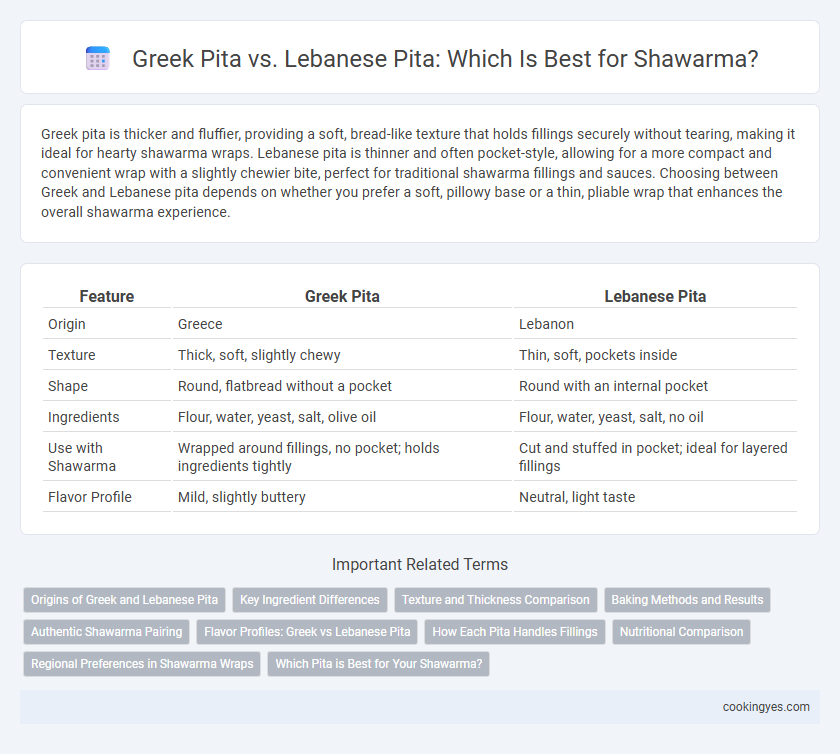Greek pita is thicker and fluffier, providing a soft, bread-like texture that holds fillings securely without tearing, making it ideal for hearty shawarma wraps. Lebanese pita is thinner and often pocket-style, allowing for a more compact and convenient wrap with a slightly chewier bite, perfect for traditional shawarma fillings and sauces. Choosing between Greek and Lebanese pita depends on whether you prefer a soft, pillowy base or a thin, pliable wrap that enhances the overall shawarma experience.
Table of Comparison
| Feature | Greek Pita | Lebanese Pita |
|---|---|---|
| Origin | Greece | Lebanon |
| Texture | Thick, soft, slightly chewy | Thin, soft, pockets inside |
| Shape | Round, flatbread without a pocket | Round with an internal pocket |
| Ingredients | Flour, water, yeast, salt, olive oil | Flour, water, yeast, salt, no oil |
| Use with Shawarma | Wrapped around fillings, no pocket; holds ingredients tightly | Cut and stuffed in pocket; ideal for layered fillings |
| Flavor Profile | Mild, slightly buttery | Neutral, light taste |
Origins of Greek and Lebanese Pita
Greek pita originates from ancient Mediterranean civilizations and is traditionally thicker and softer, designed to be folded or used as a wrap for gyros and souvlaki. Lebanese pita, also known as khubz, has roots in Levantine culture dating back thousands of years, characterized by its thin, round, and pocketed form ideal for stuffing with shawarma and other fillings. Both varieties reflect distinct regional baking techniques and cultural histories, influencing their texture and culinary applications.
Key Ingredient Differences
Greek pita dough typically includes yogurt or olive oil, resulting in a thicker, softer bread with a slightly tangy flavor, ideal for folding around gyro meat or souvlaki. Lebanese pita, made without dairy and often baked at higher temperatures, creates a thinner, duffy bread with a pocket perfect for stuffing shawarma and fresh vegetables. The difference in hydration levels and ingredients like olive oil and yogurt distinguishes the texture and taste profiles crucial for authentic shawarma preparation.
Texture and Thickness Comparison
Greek pita features a thicker, fluffier texture with a soft, bread-like consistency ideal for holding robust fillings without tearing. Lebanese pita is thinner and more flexible, characterized by a slightly chewy texture that wraps tightly around shawarma ingredients for a compact, mess-free bite. The contrast in thickness and texture directly influences the eating experience, with Greek pita offering sturdiness and Lebanese pita providing pliability.
Baking Methods and Results
Greek pita uses a dough baked on a hot stone or metal surface, creating a thick, soft bread with a pocket that holds fillings securely. Lebanese pita is baked at high temperatures in a traditional taboon oven, resulting in a thinner, fluffier bread that puffs up to form a perfect pocket ideal for shawarma. The baking method differences produce distinct textures, with Greek pita offering a denser bite, while Lebanese pita delivers a light, airy wrap.
Authentic Shawarma Pairing
Greek pita features a thicker, pocket-style bread essential for holding fillings without spillage, making it ideal for traditional shawarma wraps. Lebanese pita offers a thinner, softer texture with a slightly chewy bite, enhancing the flavor profile of authentic shawarma by allowing spices and sauces to blend more intimately. For genuine shawarma pairing, Lebanese pita delivers an authentic Middle Eastern experience, while Greek pita suits those preferring a sturdier wrap to contain rich fillings.
Flavor Profiles: Greek vs Lebanese Pita
Greek pita features a thicker, spongy texture with a mild, slightly yeasty flavor that complements grilled meats without overpowering them, making it ideal for gyros. Lebanese pita is thinner, softer, and more pliable with a subtle tang and a slight chewiness that enhances the vibrant, spiced flavor of shawarma. The contrast in texture and taste between Greek and Lebanese pita influences the overall flavor experience of shawarma dishes.
How Each Pita Handles Fillings
Greek pita is thicker and fluffier, providing a sturdy base that prevents fillings from spilling, making it ideal for holding heavier shawarma ingredients. Lebanese pita is thinner and softer with a pocket-like structure, allowing easy stuffing and an even distribution of flavors while maintaining a light texture. Each pita's unique thickness and flexibility directly influence how well it manages shawarma fillings, balancing durability and bite experience.
Nutritional Comparison
Greek pita typically contains fewer calories and less fat, making it a lighter option compared to Lebanese pita, which is generally thicker and often higher in carbohydrates and calories. Lebanese pita's higher fiber content supports digestion, while Greek pita's lower glycemic index benefits blood sugar control. Both pitas provide a good source of protein and essential minerals like iron and magnesium, but the choice depends on specific nutritional goals such as calorie control or dietary fiber intake.
Regional Preferences in Shawarma Wraps
Greek pita, known for its thicker and fluffier texture, is preferred in regions where shawarma wraps favor a heartier bread that holds ample fillings without tearing. Lebanese pita, thinner and softer with a pocket-like structure, is favored in areas emphasizing a lighter wrap that allows for easy folding and showcases the fresh ingredients inside. Regional preferences in shawarma wraps reflect these differences, with Mediterranean cuisine often pairing shawarma with Greek pita, while Middle Eastern street food traditionally uses Lebanese pita for its versatility and convenience.
Which Pita is Best for Your Shawarma?
Greek pita offers a thicker, softer texture with a pocket ideal for holding grilled meats and sauces, making it perfect for shawarma that requires sturdier bread. Lebanese pita is thinner and fluffier with no pocket, traditionally used to wrap the filling tightly, providing a lighter bite that complements delicate shawarma spices. Choosing the best pita depends on whether you prefer a substantial, pocketed wrap (Greek) or a flexible, wrap-style bread (Lebanese) for your shawarma experience.
Greek Pita vs Lebanese Pita for shawarma Infographic

 cookingyes.com
cookingyes.com